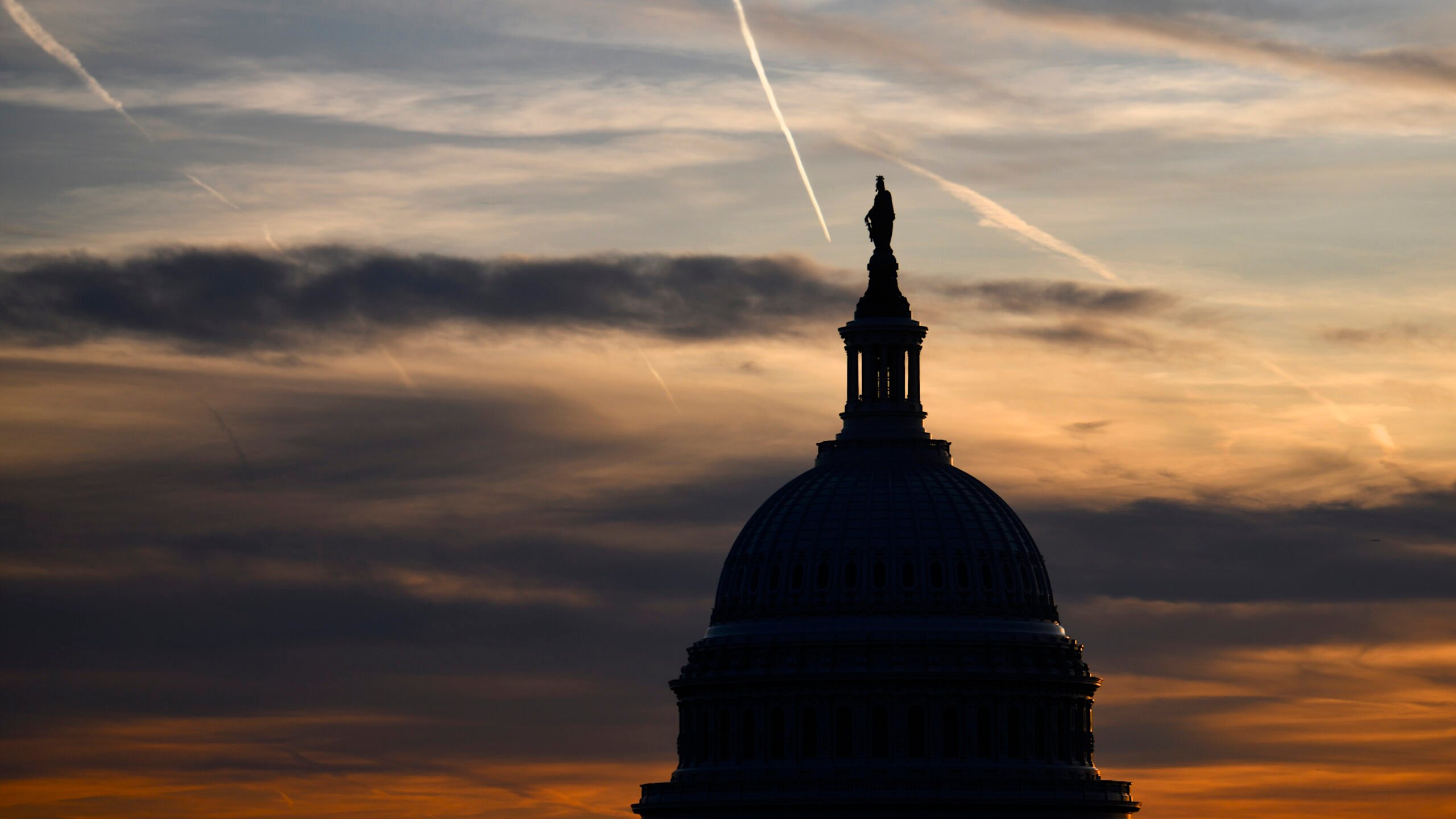
WASHINGTON, DC – NOVEMBER 13: Streaks in the sky form at sunset behind the U.S. Capitol Building on November 13, 2019 in Washington, DC. (Photo by Mark Makela/Getty Images)
With the US Congress finally passing a supplemental aid bill for Ukraine, Israel and Indo-Pacific defense spending, members might be tempted to sit back on their laurels. But John Ferrari and Elaine McCusker of the American Enterprise Institute argue in the following op-ed that with election season underway and the fiscal 2024 budget request’s future uncertain, there are key steps the Hill has to take to ensure America’s national security.
At the end of 2023, we wrote that Congress was faced with six key tasks it needed to tackle in support of the nation’s security. Four of those actions have now been completed, and Congress deserves credit for the eventual bipartisan support that led to successfully completing the first four items.
But while a 66 percent completion rate is acceptable for a quarterback, it’s not what you want to see when it comes to national security priorities. In fact, by school standards, that’s a D. With elections this fall, the clock is ticking to bring Congress’s resolution rate to 100 percent.
First, let’s acknowledge the 118th Congress’ achievements thus far. It continued its over sixty year run of passing the National Defense Authorization Act, one of the most important defense policy actions that Congress takes each year. The recently passed bipartisan emergency supplemental provides essential funding for Ukraine, Israel, and the Pacific. Third, Congress passed a two-year extension of the Foreign Intelligence Surveillance Act, and while a five-year extension would have been better, two years gets the job done for now. The fourth piece of legislative success was final passage and enactment of fiscal year 2024 appropriations, staving off further disruptive continuing resolutions, automatic budget reductions, or, in the worst case, a government shutdown.
The tasks remaining are no less fundamental, and time is short. The number of joint legislative days is scarce and the election season itself will constrain bipartisan cooperation in the coming months. As such, the administration and Congress should act now on the last two items, while adding a pivotal third item.
First, the President should submit to Congress legislative language for a proactive continuing resolution (CR) for the first half of FY25. This initially sounds illogical due to the disruptive and destructive nature of operating under CRs. But acknowledging that this just won’t be the year for a return to regular order is practical and, if done correctly, could mitigate many of the most damaging impacts.
This preemptive CR should include language that enables new starts and production increases, realigns funding for program changes, and enables the government in general, and the national security apparatus specifically, to operate through the end of February 2025. This would allow the newly-elected Congress to quickly consider and enact full 2025 appropriations as their first successful duty while focusing the federal legislature on what will be its next primary function–considering the FY26 budget. This has never been done before — and we are tempted to question our own sanity in suggesting it – but the timing is right for the administration and Congress to consider it. You won’t find many on the Hill who think the FY25 budget will be settled in the month leading up to November’s election; why wait when we know what is coming?
Second, the President should ask Congress to add the current 3.5 percent inflation rate to the Fiscal Responsibility Act’s defense budget caps, thus enabling the Pentagon budget to grow by 1 percent above the current inflation rate. With the current budget request at nearly $850 billion, an additional 3.5 percent would provide the Defense Department with roughly $30 billion in spending, nearly matching the 2025 Unfunded Priority List (UPL) request by the senior military leadership. Given that $11 billion of the UPL request was for Indo-Pacific Command, this increase would put our money where our mouth is on the pacing threat of China.
Adding urgency to get this done now is that many staff on the defense authorization and appropriations committees are already at work on the FY25 budget. The recommendations they make would be better-informed if they knew from the start the real top line and if they could factor the increase into the extended funding under the CR. As a follow-on to the recent emergency supplemental, this would also send a strong signal of U.S. resolve to Russia, Iran, North Korea, and China.
Third, but no less important: The debt ceiling returns on January 1, 2025, before the new Congress is sworn in. The administration should submit language to Congress to extend the debt ceiling by one year, giving those elected in November a full year to grapple with what has been a very difficult to solve legislative issue in the past few years.
America’s adversaries may choose to test us either leading up to or after the November elections. Providing a fiscal path that funds the government through the early part of 2025, adjusts defense spending for a minimum 1 percent real growth, and delays a potentially toxic fight over the debt ceiling would convey to the world that America is strong, resilient, and ready for any threats that may come its way.
Elaine McCusker is a senior fellow at the American Enterprise Institute. She is a former acting undersecretary of defense (comptroller). Retired US Army Maj. Gen. John Ferrari is a senior nonresident fellow at the American Enterprise Institute. Ferrari previously served as a director of program analysis and evaluation for the Army.





















